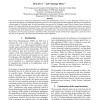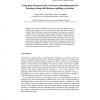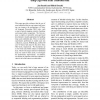82 search results - page 2 / 17 » Using Three Way Data for Word Sense Discrimination |
LREC
2010
13 years 11 months ago
2010
Given the recent trend to evaluate the performance of word sense disambiguation systems in a more application-oriented set-up, we report on the construction of a multilingual benc...
AIME
2001
Springer
14 years 2 months ago
2001
Springer
Abstract. We report on the design of a system for correcting spelling errors resulting in non-existent words. The system aims at improving edition of medical reports. Unlike tradit...
AAAI
2006
13 years 11 months ago
2006
The scarcity of manually labeled data for supervised machine learning methods presents a significant limitation on their ability to acquire knowledge. The use of kernels in Suppor...
ACL
2008
13 years 11 months ago
2008
This paper provides evidence that the use of more unlabeled data in semi-supervised learning can improve the performance of Natural Language Processing (NLP) tasks, such as part-o...
PR
2010
13 years 8 months ago
2010
: Dimensionality reduction methods (DRs) have commonly been used as a principled way to understand the high-dimensional data such as face images. In this paper, we propose a new un...



